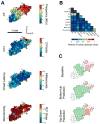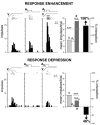Development and plasticity of intra- and intersensory information processing
- PMID: 19358458
- PMCID: PMC3639492
- DOI: 10.3766/jaaa.19.10.6
Development and plasticity of intra- and intersensory information processing
Abstract
The functional architecture of sensory brain regions reflects an ingenious biological solution to the competing demands of a continually changing sensory environment. While they are malleable, they have the constancy necessary to support a stable sensory percept. How does the functional organization of sensory brain regions contend with these antithetical demands? Here we describe the functional organization of auditory and multisensory (i.e., auditory-visual) information processing in three sensory brain structures: (1) a low-level unisensory cortical region, the primary auditory cortex (A1); (2) a higher-order multisensory cortical region, the anterior ectosylvian sulcus (AES); and (3) a multisensory subcortical structure, the superior colliculus (SC). We then present a body of work that characterizes the ontogenic expression of experience-dependent influences on the operations performed by the functional circuits contained within these regions. We will present data to support the hypothesis that the competing demands for plasticity and stability are addressed through a developmental transition in operational properties of functional circuits from an initially labile mode in the early stages of postnatal development to a more stable mode in the mature brain that retains the capacity for plasticity under specific experiential conditions. Finally, we discuss parallels between the central tenets of functional organization and plasticity of sensory brain structures drawn from animal studies and a growing literature on human brain plasticity and the potential applicability of these principles to the audiology clinic.
Figures








Similar articles
-
Multisensory orientation behavior is disrupted by neonatal cortical ablation.J Neurophysiol. 2007 Jan;97(1):557-62. doi: 10.1152/jn.00591.2006. Epub 2006 Sep 13. J Neurophysiol. 2007. PMID: 16971678
-
Do early sensory cortices integrate cross-modal information?Brain Struct Funct. 2007 Sep;212(2):121-32. doi: 10.1007/s00429-007-0154-0. Epub 2007 Jul 28. Brain Struct Funct. 2007. PMID: 17717687 Review.
-
Adult plasticity of spatiotemporal receptive fields of multisensory superior colliculus neurons following early visual deprivation.Restor Neurol Neurosci. 2010;28(2):259-70. doi: 10.3233/RNN-2010-0488. Restor Neurol Neurosci. 2010. PMID: 20404413 Free PMC article.
-
Spatial receptive field organization of multisensory neurons and its impact on multisensory interactions.Hear Res. 2009 Dec;258(1-2):47-54. doi: 10.1016/j.heares.2009.08.003. Epub 2009 Aug 19. Hear Res. 2009. PMID: 19698773 Free PMC article. Review.
-
Developmental plasticity of multisensory circuitry: how early experience dictates cross-modal interactions.J Neurophysiol. 2012 Dec;108(11):2863-6. doi: 10.1152/jn.00383.2012. Epub 2012 Jul 11. J Neurophysiol. 2012. PMID: 22786954
Cited by
-
The construct of the multisensory temporal binding window and its dysregulation in developmental disabilities.Neuropsychologia. 2014 Nov;64:105-23. doi: 10.1016/j.neuropsychologia.2014.08.005. Epub 2014 Aug 13. Neuropsychologia. 2014. PMID: 25128432 Free PMC article. Review.
-
Interactions between space and effectiveness in human multisensory performance.Neuropsychologia. 2016 Jul 29;88:83-91. doi: 10.1016/j.neuropsychologia.2016.01.031. Epub 2016 Jan 27. Neuropsychologia. 2016. PMID: 26826522 Free PMC article.
-
Auditory map plasticity: diversity in causes and consequences.Curr Opin Neurobiol. 2014 Feb;24(1):143-56. doi: 10.1016/j.conb.2013.11.009. Epub 2013 Dec 13. Curr Opin Neurobiol. 2014. PMID: 24492090 Free PMC article. Review.
-
Stimulus intensity modulates multisensory temporal processing.Neuropsychologia. 2016 Jul 29;88:92-100. doi: 10.1016/j.neuropsychologia.2016.02.016. Epub 2016 Feb 23. Neuropsychologia. 2016. PMID: 26920937 Free PMC article.
-
The importance of right otitis media in childhood language disorders.Int J Otolaryngol. 2012;2012:818927. doi: 10.1155/2012/818927. Epub 2012 Mar 26. Int J Otolaryngol. 2012. PMID: 22536255 Free PMC article.
References
-
- Bakin JS, South DA, Weinberger NM. Induction of receptive field plasticity in the auditory cortex of the guinea pig during instrumental avoidance conditioning. Behav Neurosci. 1996;110(5):905–913. - PubMed
-
- Bakin JS, Weinberger NM. Classical conditioning induces CS-specific receptive field plasticity in the auditory cortex of the guinea pig. Brain Res. 1990;536(1-2):271–286. - PubMed
-
- Bao S, Chan VT, Merzenich MM. Cortical remodelling induced by activity of ventral tegmental dopamine neurons. Nature. 2001;412(6842):79–83. - PubMed
Publication types
MeSH terms
Grants and funding
LinkOut - more resources
Full Text Sources
